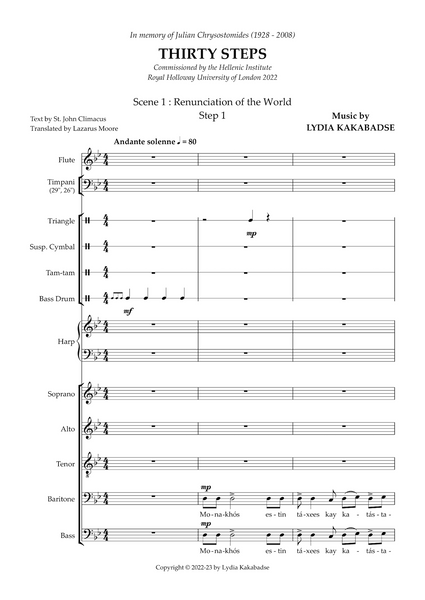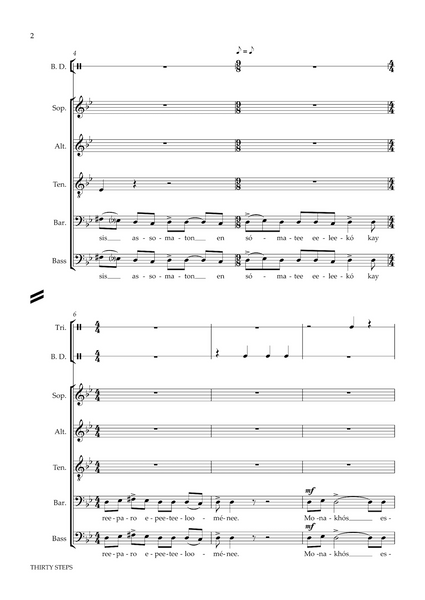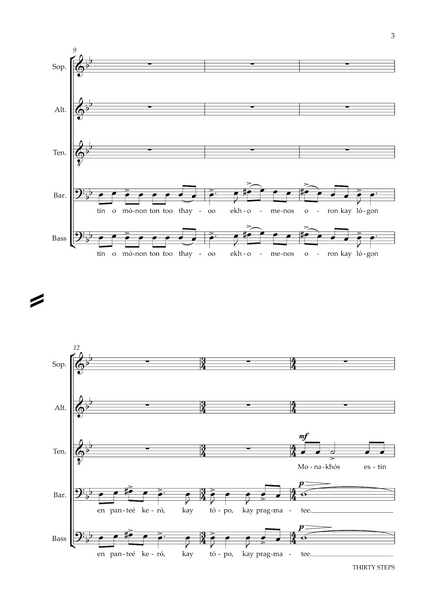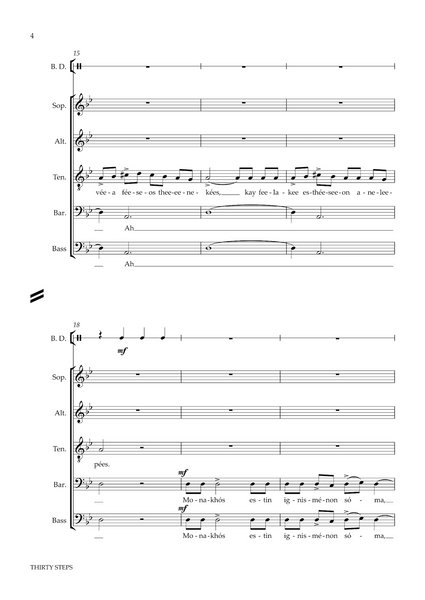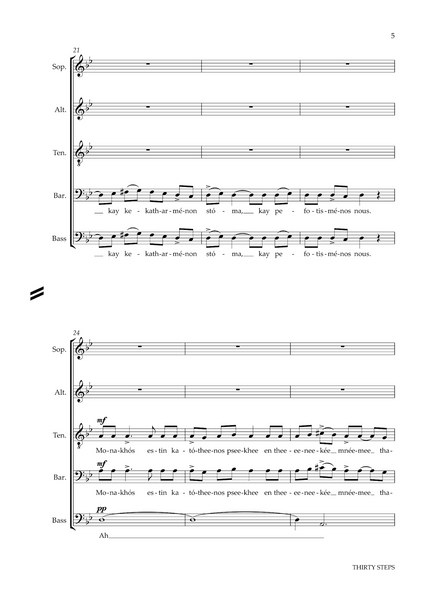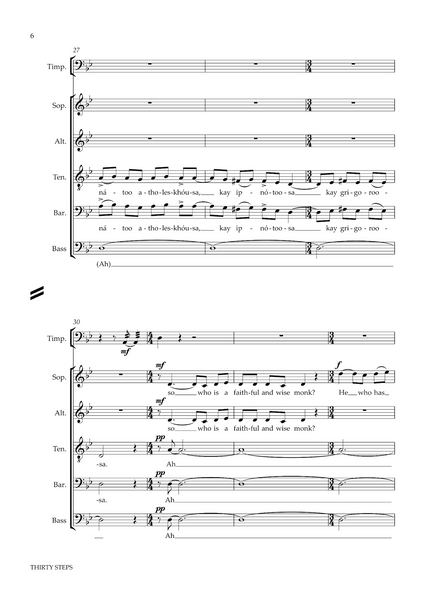Lydia Kakabadse: Thirty Steps – for mixed voice choir (SATBB) with flute, harp and percussion (NXP157)
This is a sheet music edition of Thirty Steps by the composer Lydia Kakabadse.
Sheet music for mixed choir (SATBB) with flute, harp & percussion
Score: 128 pages
Flute: 6 pages
Harp: 12 pages
Percussion (Timpani, Triangle, Susp. Cymbal, Tam-tam, Bass Drum): 10 pages
Duration: 48:23 minutes
Audio samples
Listen to audio samples of the Thirty Steps in the track listing of the album page at Divine Art Recordings.
Preface and programme notes
In 2022, The Hellenic Institute at Royal Holloway University of London commissioned me to write a choral work Thirty Steps to portray a musical journey of spiritual growth. The lyrics, sung in English (except for Steps 1 and 23, which are chanted in the original Greek) have been selected from The Ladder of Divine Ascent, an ascetic guide, written by St John Climacus of Sinai (ca. 579 – ca. 649 CE).
Completed in June 2023 and scored for mixed choir (SATBB) with harp, flute and percussion including timpani, the instrumental ensemble is used rather sparingly to provide distinctive tone colour and dramatic effects.
Thirty Steps has been recorded on the Divine Art label and is included in my choral/chamber album “Kefi.”
Scene 1: Renunciation of the World
Step 1 commences with the solemn beat of the bass drum heralding the baritone and bass voices, chanting in Greek. Joined by the tenors, the male voices continue to chant, renouncing their earthly materialistic pleasures. The simplicity of the chanting not only symbolises the first stage of spiritual development but also the early beginnings of the Hellenic Institute. The mood changes when the sopranos and altos enter, each interacting with the other in antiphonal manner, over a perfect 5th male voice drone.
Repeating the monophonic texture of the opening step, Step 2 starts with the voices singing in unison. The harp makes its first entry glissando a piacere (gliding at will) accompanying the solo alto, who issues a stark warning: “let him who runs the race imitate not Lot’s wife but Lot himself and flee.”
Step 3 introduces a mood of foreboding and tension, created by percussion effects and the flute’s flutter tonguing, and centres around how dreams can really be tricks from devils.
In contrast, Step 4 is calmer with the choir singing a cappella on the theme of practising unquestioning obedience to a superior.
Scene 2: Penitence
Without sopranos and instrumental accompaniment, Step 5 is sung grave solenne (slow and solemn) by the altos, above a slow-moving humming accompaniment. It is reflective in nature, relating to escaping punishment by voluntarily accepting retribution.
Written in a quasi-syncopated lullaby style, Step 6 continues the humming accompaniment and depicts the impossibility of repentance without remembrance of death. The main theme, first announced by the sopranos, is then taken up by the tenors over a baritone drone, and later by the altos.
Step 7 begins with the sopranos alternating with the rest of the choir in antiphonal style on the importance of mourning. In a variation of the quasi-syncopated lullaby of the previous step, the solo tenor sums up the essence of the seventh step.
Scene 3: Overcoming Vices
The male voices remain silent during Step 8. Accompanied by harp and percussion, and utilising the double harmonic major scale of C, the flute announces the main theme and goes on to interact with the altos and then the sopranos.
Step 9 continues with the same musical scale. Accompanied by timpani and jazz-style harp, the baritone and bass voices introduce the main theme to the words: “Remembrance of wrongs is the consummation of anger.” The sopranos, altos and tenors each take up this theme with variations, as does the flute in syncopated style.
Step 10, Step 11 and Step 12, all written in the key of A minor, make use of responsorial singing without instrumental accompaniment. Step 13, scored for sopranos and altos, blossoms from bare intervals to rich harmony, exuding an emotional depth and energy on the theme of despondency.
Performed pesante (in a heavy, ponderous manner), Step 14 is characterized by the use of parallel octaves, augmented 2nds, open triads and a heavy drumbeat. The main theme is introduced by the baritones and basses singing: “Gluttony is a delusion of the eyes.”
Centring around the subject of purity, Step 15 begins with the solo tenor introducing the main theme, which is later developed by the sopranos with harp accompaniment. This further develops into a call-and-response form, where questions asked by the tenors are responded to by the upper voices.
Step 16 is characterised by two distinct phrases – the first sung by male voices and the second, in direct response, by the female voices.
Step 17 is similar in style, where two distinct sections of the choir interact with each other, singing alternative musical phrases.
Scene 4: Self Denial
The mood in Step 18 is anguished and melancholy. The sopranos sing in the lower register over slow moving chords in the key of G minor. The male voices then sing in chordal style, bringing this step to a close in the relative major key of B-flat.
Step 19 begins in F major with the harp playing tranquillo in lullaby style. The upper voices enter, singing a third apart. The mood changes when the choir sings in chordal style following a key change to B-flat minor and, without pause, continues straight into Step 20.
Accompanied by the harp, bass drum and suspended cymbal, the flute plays a haunting melody – repeated towards the end – creating an uneasy sense of foreboding. The sopranos enter over a slow descending chromatic sequence sung by the altos and male voices, further adding to the sense of unease.
The mood swiftly becomes more upbeat in Step 21 as the baritones and basses introduce the main theme, in unison, which, in turn, is developed by the tenors and later the upper voices.
Step 22 is written in the style of a ballad in compound duple time. Over an open 5th harp accompaniment, the solo alto sings: “Who among men knows the thoughts of a man, except the spirit of a man within him?” Joined by the solo soprano, they sing together in intervals of a 3rd and 6th. The altos, accompanied by humming male voices, repeat the opening melody of the solo alto, following which the sopranos bring the piece to a close with a repeat of the solo soprano’s melody.
Similar to Step 1, Step 23 commences with the beat of the bass drum, heralding the sopranos and altos chanting in unison in Greek and continuing over a perfect 5th male voice drone. The chanting ends when the choir switches to English, proclaiming: “A proud monk has no need of a devil.”
Introduced by the solo tenor in compound duple time in a style similar to Step 22, Step 24 is characterized by the choir alternating with the flute and harp.
Whilst Step 25 centres around slow moving chordal progressions, interspersed with female voices alternating with the tenors, Step 26 concludes Scene 4 with cadence patterns widely used in the Russian Orthodox liturgy. Starting in the minor key and appearing at the end of each chant, the cadence pattern ends in the major key using the following melodic configuration: tonic-leading note-submediant-tonic.
Scene 5: Acquiring Peace of the Soul
Accompanied by the harp and sung in canon style, Step 27 centres around the subject matter of solitude and, in particular, the power of a solitary monk, which lies “in abundance of prayer.”
Step 28 begins and ends with the tenors singing about the virtues of prayer. For the most part, the baritones and basses provide a perfect 5th bass drone, over which the tenors and sopranos alternate, followed by the altos and tenors singing in tandem.
Beginning in E minor, Step 29 alternates between the choir’s rich four-part harmony and the solo soprano, ending with the solo soprano singing in the relative major (G) over the choir’s sustained humming.
Scene 6: The Supreme Trinity of the Virtues
The final step, Step 30, brings together a range of different styles and thematic material from earlier scenes and includes dramatic input from the flute, harp and percussion creating an atmospheric sonic landscape and ending in triumphant style.
Recording
Thirty Steps has been recorded on the Divine Art label and is included in my choral/chamber album of the same namesake.
“Her music is melodic, appealing, definitely influenced by Eastern modes, and complex enough to reward repeated hearings. She has a terrific ear for color, and combines instruments in a highly imaginative way.”
– Henry Fogel (Fanfare Magazine)
“Lydia Kakadbase writes in an instantly appealing style ... This extremely enjoyable disc of chamber and vocal music is most welcome and ought to make many new friends for her music.”
– Philip Reed, Choir & Organ Magazine Winter 2024







